Week 1: October 31 – November 6, 2009
|
|
| THIS WEEK | THIS FALL | 2009 TOTAL | SITE TOTAL | |
|---|---|---|---|---|
| # birds (and species) banded | 28 (8) | 28 (8) | 4422 (84) | 23343 (105) |
| # birds (and species) repeat | 15 (5) | 15 (5) | 900 (50) | 4247 (66) |
| # birds (and species) return | 1 (1) | 1 (1) | 161 (32) | 615 (37) |
| # species observed | 39 | 39 | 166 | 199 |
| # net hours | 157.0 | 157.0 | 9352.9 | 39818.2 |
| # birds banded / 100 net hours | 17.8 | 17.8 | 47.2 | 58.6 |
Note: table does not include nocturnal banding (owls)
Banders-in-charge: Simon Duval, Marcel Gahbauer, Gay Gruner
Assistants: Jenia Faibusovitch, Barbara Frei, Bana Hamze, Marie-Anne Hudson, Kristen Keyes, Chris Murphy, Rodger Titman
Notes: Last week our official fall migration monitoring program ended, but we had so many birds still moving through over the final couple of days that we decided to continue with the full protocol for a while longer to see when migration would taper off. Well, as it turned out, we didn’t have to wait long to answer that question! On Saturday morning the site was still teeming with birds, with American Robins, Slate-coloured Juncos, American Tree Sparrows, and Fox Sparrows especially numerous. However, it was windy and rainy, so no banding was possible. That afternoon the winds gusted up to 80 km/h, and when the skies cleared at night, it seems like most birds decided to clear out, as Sunday was remarkably quiet in contrast to what we had become accustomed to. Monday was more silent yet, with only 7 birds banded in a full morning of operation, so we decided to shut down at that point and continued with census and supplemental observations for the rest of the week, and they confirmed that numbers remained low.
Despite the much lower numbers, we still had some interesting moments this week. On Sunday we banded another Northern Shrike, quite different in appearance from the one we had just a couple of days before (see the photo below). The Townsend’s Solitaire first discovered on the last day of the fall season has stayed around all week, though it is elusive, and has only been spotted every few days. The local Pileated Woodpeckers have been particularly active this week, after being unusually scarce this fall. And thanks to a generous donation of seeds from the Centre de Conservation de la Faune Ailée, we have the MBO feeders well stocked, and they are already attracting a good number of sparrows, finches, and other birds.
|
|
Owling continued several nights this week, and again we have a few interesting results to report. The Eastern Screech-Owl above was a nice way to finish off the week, but prior to it we had banded another 6 Northern Saw-whet Owls. Also this week we recaptured one saw-whet that we banded over two weeks earlier, suggesting that perhaps it is considering remaining in the area over winter. But the most exciting development of the week was on Sunday night, when one of the owls we had banded earlier this season was recaptured over 700 km to the south at Lamb’s Knoll, Virginia – a substantial distance to move in less than three weeks!
|
|
All of a sudden, our top ten list of birds banded this week is back to being a short and meager compilation, with not even enough species to fill the whole table. Last week’s top five remained on top this week, albeit a bit jumbled up … but given that fifth place was achieved with only two individuals this week, it’s not terribly meaningful. Certainly times like this are about the only way in which species like Northern Shrike and Northern Cardinal will ever get featured in this part of the program reports!
| # individuals banded | mean # individuals observed daily |
|---|---|
| 1. Slate-coloured Junco (10) [1] | 1. Red-winged Blackbird (195) [1] |
| 2. Black-capped Chickadee (6) [3] | 2. American Robin (68) [2] |
| 3. Fox Sparrow (4) [5] | 3. Slate-coloured Junco (43) [5] |
| 4.American Tree Sparrow (3) [2] | 3. Canada Goose (43) [4] |
| 5. White-throated Sparrow (2) [4] | 5. American Crow (30) [3] |
| 6. Northern Shrike (1) [-] | 6. American Goldfinch (17) [-] |
| 6. American Robin (1) [9] | 7. Black-capped Chickadee (16) [6] |
| 6. Northern Cardinal (1) [-] | 8. Mallard (9) [7] |
| 9. White-throated Sparrow (8) [8] | |
| 10. European Starling (8) [10] |
Red-winged Blackbirds and American Robins remained the most numerous birds observed at MBO this week, but their numbers were down considerably, and the same holds true for the rest of the top ten. The only addition to the list this week was American Goldfinch, largely thanks to a flock of 48 observed on Thursday morning, perhaps already attracted by the feeders. In all, the 39 species observed this week was a record high for the first week of November, and more in fact than we’ve sometimes had in the whole month. No doubt that was influenced to some extent by the extra effort on site this week, and we expect the list to grow much more slowly over the rest of the winter. For the remainder of the season we will return to posting one update per month, then will resume with weekly reports when the spring season begins at the end of March.
|
|
November 7-30, 2009
|
|
| THIS PERIOD | THIS WINTER | 2009 TOTAL | SITE TOTAL | |
|---|---|---|---|---|
| # birds (and species) banded | 157 (13) | 185 (14) | 4579 (86) | 23500 (105) |
| # birds (and species) repeat | 74 (8) | 89 (10) | 974 (51) | 4321 (66) |
| # birds (and species) return | 5 (3) | 6 (4) | 166 (32) | 620 (37) |
| # species observed | 40 | 48 | 166 | 199 |
| # net hours | 85.0 | 242.0 | 9437.9 | 39903.2 |
| # birds banded / 100 net hours | 184.7 | 76.4 | 48.4 | 58.9 |
Note: table does not include nocturnal banding (owls)
Banders-in-charge: Simon Duval, Marcel Gahbauer, Gay Gruner
Assistants: Nicki Fleming, Alain Goulet, Marie-Anne Hudson, James Junda, Kristen Keyes, Barbara and Don MacDuff
Notes: This year we continued with our fall banding setup into the first week of November, but the results were rather poor in terms of banding. That period was featured in our previous report, while this one covers the rest of the month, during which we operated at our more traditional winter setup around the feeders.
Not surprisingly, capture rate was substantially higher around the feeders. One of the aims of banding frequently early in winter is to mark the population of locally wintering birds so that we can track their occurrence throughout the season. We had five banding sessions between November 15 and 29, with the number of new captures ranging from 23 to 44 each time. Over time we expect the number of new captures to decline as recaptures become more frequent, but we still had 36 new birds on Nov 29, indicating that we are far from having marked the whole population using the MBO feeders.
|
|
American Goldfinches and Slate-coloured Juncos dominated this month, with House Finches not far behind. Both House Finches and Mourning Doves were banded for the first time in three years, and in considerable abundance, with the totals for the month higher than two of three previous full winter seasons … and plenty of unbanded individuals still around at the end of the month. We also recaptured a female House Finch banded at MBO in December 2006, suggesting some site fidelity. The number of Slate-coloured Juncos banded suggests that migrants were still arriving in November, whereas only a small minority of the Black-capped Chickadees caught were unbanded. Surprises at the net included American Robin and Red-winged Blackbird – not only late in the year, but typically not associated with feeders.
|
|
Usually in winter we don’t post a table of the most frequently banded and observed species like we do during migration, but we had such an active month this time that it’s worth including it for the sake of comparison with late fall data. The banding list is topped by our five most numerous feeder visitors, though the Black-capped Chickadees are under-represented as most of the local population has been previously banded. Once the corn in the adjacent field was cut in the second week of November, the Canada Geese took advantage, with as many as 800 present there one morning. Mallard and American Crow numbers increased too, albeit not as drastically. Ranked fourth through eighth are the dominant species at the feeders this month. Chickadee counts have ranged as high as 40 individuals, while top counts for the others are 38 for American Goldfinch, 28 for Slate-coloured Junco, 36 for Mourning Dove, and 28 for House Finch. The Mourning Dove numbers are particularly impressive as we have not seen such numbers since 2005. Whereas their numbers were already growing a couple of weeks before we put the feeders up, the House Finches seem to have arrived in direct response to our offerings.
| # individuals banded | mean # individuals observed daily |
|---|---|
| 1. American Goldfinch (56) [-] | 1. Canada Goose (161) [3] |
| 2. Slate-coloured Junco (35) [1] | 2. American Crow (67) [5] |
| 3. House Finch (31) [-] | 3. Mallard (30) [8] |
| 4. Mourning Dove (10) [-] | 4. Black-capped Chickadee (19) [7] |
| 5. Black-capped Chickadee (6) [2] | 5. American Goldfinch (17) [6] |
| 6. American Tree Sparrow (5) [4] | 6. Slate-coloured Junco (15) [3] |
| 7. American Robin (4) [6] | 7. Mourning Dove (14) [-] |
| 8. Fox Sparrow (3) [3] | 8. House Finch (10) [-] |
| 8. White-throated Sparrow (3) [4] | 9. American Robin (9) [2] |
| 10. Four species tied (1) | 10. Blue Jay (6) [-] |
Out of the 40 species observed between November 7 and 30, 17 were recorded on just one of our 12 visits: Cackling Goose, Herring Gull, Great Black-backed Gull, Rock Pigeon, Peregrine Falcon, Pileated Woodpecker, Common Raven, Red-breasted Nuthatch, Brown Creeper, Carolina Wren, Townsend’s Solitaire, Gray Catbird, Cedar Waxwing, Bohemian Waxwing, Common Grackle, Pine Siskin, and House Sparrow. Some of these sightings are of special note. Great Black-backed Gull is a rare species at MBO, and the flock of 11 that flew over on November 29 was a new high count for the site. The Carolina Wren was only the second record for the site, while the Townsend’s Solitaire was almost certainly the same bird first spotted on the final day of the fall program. The Gray Catbird on November 15 set a new record late for MBO, and was not likely one of the local birds, as none had been seen for a few weeks previous to this sighting. The fact that over 40% of species during this period were observed on a single day suggests there is good value in continuing census and other observations as frequently as possible in winter!
|
|
December 1 – 31, 2009
|
|
| THIS PERIOD | THIS WINTER | 2009 TOTAL | SITE TOTAL | |
|---|---|---|---|---|
| # birds (and species) banded | 9 (6) | 194 (14) | 4588 (86) | 23509 (105) |
| # birds (and species) repeat | 20 (4) | 109 (10) | 994 (51) | 4341 (66) |
| # birds (and species) return | — | 6 (4) | 166 (32) | 620 (37) |
| # species observed | 27 | 48 | 166 | 199 |
| # net hours | 20.0 | 262.0 | 9457.9 | 39923.2 |
| # birds banded / 100 net hours | 45.0 | 74.0 | 48.4 | 58.9 |
Note: table does not include nocturnal banding (owls)
Banders-in-charge: Simon Duval, Gay Gruner
Assistants: Marie-Anne Hudson, Kristen Keyes, Barbara and Don MacDuff, Chris Murphy
Notes: This year November was unusually mild and sunny, but as soon as the calendar turned to December, the weather took a turn for the worse, becoming frequently cold and snowy. Not surprisingly, this chased out many of the lingering late migrants, with only a handful of American Robin sightings this month, and most of the Canada Geese flocks not seen past the first week of December. Even at the feeders, action was reduced, and accordingly we also eased off on our monitoring efforts. American Tree Sparrows and Slate-colored Juncos were at the forefront of the short banding list this month, though they were outnumbered by recaptures of local Black-capped Chickadees. Among the species observed in December, highlights included Merlin, Northern Goshawk, Rough-legged Hawk, and a White-crowned Sparrow that showed up later in the month.
| # individuals banded | mean # individuals observed daily |
|---|---|
| 1. American Tree Sparrow (3) [6] | 1. Canada Goose (237) [1] |
| 2. Slate-coloured Junco (2) [2] | 2. American Crow (21) [2] |
| 3. Hairy Woodpecker (1) [-] | 3. Black-capped Chickadee (16) [4] |
| 3. White-throated Sparrow (1) [8] | 4. Mourning Dove (14) [7] |
| 3. House Finch (1) [3] | 5. Slate-coloured Junco (8) [6] |
| 3. American Goldfinch (1) [1] |
|
|
January 1 – 31, 2010
|
|
| THIS PERIOD | THIS WINTER | 2010 TOTAL | SITE TOTAL | |
|---|---|---|---|---|
| # birds (and species) banded | 17 (5) | 211 (15) | 17 (5) | 23526 (105) |
| # birds (and species) repeat | 7 (2) | 116 (10) | 7 (2) | 4348 (66) |
| # birds (and species) return | 1 (1) | 7 (4) | 7 (4) | 621 (37) |
| # species observed | 21 | 51 | 21 | 199 |
| # net hours | 8 | 254 | 8 | 39915.2 |
| # birds banded / 100 net hours | 212.5 | 83.1 | 212.5 | 58.9 |
Note: table does not include nocturnal banding (owls)
Banders-in-charge: Simon Duval, Gay Gruner
Assistants: Mike Beaupré, Gilles Burelle, Christine Burt, Chris Cloutier, Jean Demers, Nicki Fleming, Barbara Frei, Malcolm Johnson, Kristen Keyes, Helen Leroux, Barbara MacDuff, Chris Murphy, Greg Rand, Clémence Soulard.
Notes: January’s weather ran the gamut, with temperatures ranging from -18° to 2°, moderate to low amounts of snowfall and just over 30 mm of rain. Overall however, the temperatures were mild, allowing eleven days of onsite observation, one day of banding and three very productive days of site maintenance.
Among the species observed in January, highlights included Common Raven (two performing an aerial display worthy of Cirque du Soleil) and a Northern Shrike, who uncannily appeared on our one day of banding (though stayed out of the nets). White-throated Sparrow and American Tree Sparrow have become regular feeder-area visitors, and were spotted 10 and 9 days respectively out of our eleven observation periods. House Finch was observed on one day only, contrasting sharply with how frequently they were seen in December. Where did they go? We know relatively little about the movements of House Finch and American Goldfinch during winter. MBO is considering a research project for next winter to gain some insights into their movements. For that matter, the winter movements of Black-capped Chickadees may be interesting too – considering how many we banded in late fall and early winter, it was quite surprising to catch 11 unbanded individuals this month.
Habitat management took front and centre stage this month. Over the past 5 years the cattails in Stoneycroft Pond have increased and were in danger of “choking” the pond. The decrease in open water and lack of channels among the cattails has made the pond less attractive to wildlife for use as a stopover and/or for nesting purposes. Research has shown that if the aerial shoots of cattails are cut as low as possible and a spring flood covers the shoots long enough to block the oxygen supply to the rhizome, the plant will die. Well, we can’t predict the spring flood, but the cattails on the east side of the pond are now cut in readiness of one! We left the west side untouched for our Red-winged Blackbirds, as that stand has been present and used by them (and others) for many years. Even if this year’s spring flood will not be high enough to cut off the oxygen supply and kill the plants, there will definitely be more open water in the pond for wildlife to use this spring. This back-breaking task was made lighter by the humorous and positive attitude of a super group of volunteers – MBO volunteers are the best! Thank you very much for your time and energy on this important project.
| # individuals banded | mean # individuals observed daily |
|---|---|
| 1. Black-capped Chickadee (11) [-] | 1. European Starling (72) [-] |
| 2. American Tree Sparrow (2) [1] | 2. Black-capped Chickadee (13) [3] |
| 2. Northern Cardinal (2) [-] | 3. Slate-coloured Junco (9) [5] |
| 3. Slate-coloured Junco (1) [2] | Mourning Dove (5) [4] |
| 3. American Goldfinch (1) [3] | 5. American Goldfinch (5) [-] |
|
|
February 1 – 28, 2010
|
|
| THIS PERIOD | THIS WINTER | 2010 TOTAL | SITE TOTAL | |
|---|---|---|---|---|
| # birds (and species) banded | 21 (4) | 232 (15) | 38 (6) | 23547 (105) |
| # birds (and species) repeat | 12 (2) | 128 (11) | 19 (2) | 4360 (66) |
| # birds (and species) return | 0 (0) | 7 (4) | 1 (1) | 621 (37) |
| # species observed | 23 | 52 | 25 | 199 |
| # net hours | 20 | 274 | 28 | 39935.2 |
| # birds banded / 100 net hours | 95.2 | 84.7 | 135.7 | 59.0 |
Note: table does not include nocturnal banding (owls)
Banders-in-charge: Simon Duval, Gay Gruner
Assistants: Mike Beaupré, Chris Cloutier, Jean Demers, Malcolm Johnson, Barbara MacDuff, Donald MacDuff, Chris Murphy, Mariner Palmer, Greg Rand, Clémence Soulard.
Notes: Overall, February temperatures were mild, despite an initial cold spell and, at the end of the month, ferocious winds. We observed 23 species over 12 observation periods. A flock of Snow Buntings flew over MBO, increasing our winter species list to 52; we also added four new species for 2010: Great Black-backed Gull, Brown Creeper, Bohemian Waxwing and, of course, Snow Bunting. House Finch remained fickle to the MBO feeders for all but the last two days of the month, when they mysteriously appeared in good numbers. A big thank you to the dedicated censusers who regularly make the MBO trek and spot the birds. Observations are a vital component of the MBO data.
We managed two banding days and were astounded to band another 10 Black-capped Chickadees for the season. Several unbanded chickadees, such as the one pictured below, continue to frequent the feeders! More study of the movement patterns of winter finches and chickadees is definitely needed.
|
|
Anyone who has ever been to the MBO is familiar with our windmill. Its tall structure, silhouetted against the morning sun, has been captured in countless photographs. Unfortunately, the blades of the windmill dropped off on February 21, leaving us (and several Tree Swallows and Brown-headed Cowbirds) to pine for the squeaky, screechy landmark and favourite perch. Oddly enough the blades dropped off five days prior to the extreme gusts which occurred on February 26 and left the MBO site strewn with branches and bark from wind-whipped trees.
| # individuals banded | mean # individuals observed daily |
|---|---|
| 1. Black-capped Chickadee (10) [1] | 1. Black-capped Chickadee (12) [2] |
| 2. Mourning Dove (6) [-] | 2. Mourning Dove (11) [4] |
| 3. American Goldfinch (3) [5] | 3. Slate-coloured Junco (8) [3] |
| 4. American Tree Sparrow (2) [2] | 4. American Crow (7) [-] |
| 5. Blue Jay (5) [-] |
|
|
Weeks 18-21: March 1 – 27, 2010
|
|
| THIS PERIOD | THIS WINTER | 2010 TOTAL | SITE TOTAL | |
|---|---|---|---|---|
| # birds (and species) banded | 85 (9) | 317 (17) | 123 (10) | 23632 (105) |
| # birds (and species) repeat | 11 (3) | 139 (11) | 30 (4) | 4371 (66) |
| # birds (and species) return | 8(4) | 15 (5) | 9 (3) | 629 (37) |
| # species observed | 40 | 58 | 41 | 199 |
| # net hours | 38 | 312 | 66 | 39973.2 |
| # birds banded / 100 net hours | 95.2 | 101.6 | 186.4 | 59.1 |
Note: table does not include nocturnal banding (owls)
Banders-in-charge: Simon Duval, Gay Gruner
Assistants: Christine Barrie, Chris Cloutier, Jean Demers, Malcolm Johnson, Barbara MacDuff, Donald MacDuff, Chris Murphy, Greg Rand, Clémence Soulard
Notes: March weather was a treat; the mean temperature for the month was 7.8°C, with some days setting record highs of 14° and 15° (in comparison, over the past 5 years, the March mean has been between 0°C and 3°C). The lure to go birding could not be ignored. We observed 40 species (almost double the 23 species observed in February) and, as is typical of March, the birds were a mix of winter residents and early spring arrivals. (Picture American Tree Sparrow and Northern Shrike sharing the trees and treetops with mobs of screaming Red-winged Blackbirds. Black-capped Chickadees were not at all disturbed by the ruckus and carried on flying between feeders and trees with their usual equanimity.)
We added six species to the 2009-2010 winter list bringing the season total to 58: Great Blue Heron, Turkey Vulture, Bald Eagle, Killdeer, Brown-headed Cowbird and House Sparrow. In addition to those six species, these early returning migrants were also new for 2010: Canada Goose, Wood Duck, Mallard, Sharp-shinned Hawk, Red-shouldered Hawk, Ring-billed Gull, Song Sparrow, Red-winged Blackbird, Common Grackle and Purple Finch.
Banding highlights in March included 23 American Tree Sparrows, a species which is usually undersampled at MBO due to being a very late fall and early spring migrant. Red-wings charged the nets on the final day of winter banding (13 male and 1 especially early female). We recaptured a male Red-winged Blackbird that was first banded in spring of 2005 – an excellent example of site fidelity. It was aged as an after-second year in 2005, which makes it at least 7 years old! Other highlights included a female European Starling, hardly a rare species, but one rarely caught at MBO (an average of only one per year).
|
|
The Wood Duck boxes are cleaned and prepared for spring occupancy; hopefully the drakes and hens we have been observing recently will set up house. The census trail is clear, although in need of some work. And that is a good segue to an announcement about our Maintenance Day planned on Saturday, April 10. There are many tasks ranging from light to heavy labour – we hope to have a good turnout of volunteers (hint hint)!
Once again, many thanks to the winter censusers. It is not easy tramping the census route in bad weather and your dedication is greatly appreciated. We are now switching over to the Spring Migration Monitoring Program, which will begin as usual with three weeks of daily census, then expand to include full banding efforts for 45 days from April 18 to June 1.
| # individuals banded | mean # individuals observed daily |
|---|---|
| 1. American Tree Sparrow (23) [4] | 1. Canada Goose (171) [-] |
| 2. Black-capped Chickadee (21) [1] | 2. Red-winged Blackbird (29) [-] |
| 3. American Goldfinch (19) [3] | 3. American Crow (27) [4] |
| 4. Red-winged Blackbird (14) [-] | 4. American Goldfinch (15) [-] |
| 5. Song Sparrow (3) [-] | 5. Black-capped Chickadee (14) [1] |
|
|
2009-2010 SEASON SUMMARY
| WINTER 2009/10 | OCT/NOV | DEC | JAN | FEB | MAR | TOTAL |
|---|---|---|---|---|---|---|
| Number of days within winter season | 31 | 31 | 31 | 28 | 27 | 148 |
| Number of days of observation | 19 | 8 | 11 | 12 | 13 | 63 |
| Number of banding sessions | 7 | 2 | 1 | 2 | 4 | 16 |
| Number of birds (and species) banded | 185 (14) | 9 (6) | 17 (5) | 21 (4) | 85 (9) | 317 (17) |
| Number of birds (and species) repeat | 89 (10) | 20 (4) | 7 (2) | 12 (2) | 11 (3) | 139 (11) |
| Number of birds (and species) return | 6 (4) | – | 1 91) | – | 8 (4) | 15 (5) |
| Number of species observed | 48 | 27 | 21 | 23 | 40 | 58 |
| Number of net hours | 242 | 20 | 8 | 20 | 38 | 312 |
| Number of birds banded per 100 net hours | 76.4 | 45.0 | 212.5 | 95.2 | 95.2 | 101.6 |
The winter season at McGill Bird Observatory spans the gap between the fall and spring migration seasons, a total of just over 21 weeks from the last day of October through March 27. Unlike the daily monitoring during migration, activities at MBO in winter are more sporadic, limited largely by weather conditions, especially when it comes to banding. Few other bird observatories this far north are open in winter at all, so even part-time operations can be useful in terms of monitoring the winter occurrence of birds.
This winter was relatively mild, with far below average snowfall. We were able to conduct observations on 42% of days this winter, a substantial improvement over the past couple of years. During this period we banded 317 birds, eclipsing by one the record of 316 set in winter 2005/2006. Although American Goldfinch topped the charts, the number of Black-capped Chickadees (54) banded was perhaps more suprising, as we would have expected a stable wintering population, but over half of these birds were banded in February or March, suggesting some movement of individuals during winter. House Finch movement patterns also confounded us – we banded 32 in November and December, but have not caught a single one yet in 2010! Also of note this winter was a record count of American Tree Sparrow (38), more than doubling the cumulative total over all previous winters. On the downside, Common Redpolls were completely absent this winter, we had only a single observation of Pine Siskin, and Bohemian Waxwing sightings were infrequent too.
The winter season actually started off slowly with 27 species observed, down from last year’s 36. This number stayed more or less consistent throughout the season, despite variation in the number of observer days. This is likely due to the stabilizing effect of the feeders. Overall we ended up with 51 species observed, up from last year’s 40, and similar to the 49 in 2006 – 2007. There were a few more observation days this year, compared to last year, but we attribute the higher number of species to the full feeders, and not the added observers.
| Top 5 species banded (# of individuals) | Top 5 species observed |
|---|---|
| 1. American Goldfinch (80) | 1. Canada Goose |
| 2. Black-capped Chickadee (54) | 2. Red-winged Blackbird |
| 3. Slate-colored Junco (50) | 3. American Crow |
| 4. American Tree Sparrow (38) | 4. European Starling |
| 5. House Finch (32) | 5. Black-capped Chickadee |
This winter began with a boom, with nearly 200 birds banded, and 48 species observed – more than have been seen in average winter at MBO over the past 5 years! To some extent this may reflect a high level of observer effort in November, but it probably also was influenced by unusually mild temperatures for much of the month, allowing some late fall migrants to linger longer than they typically would. At the other end of winter, March temperatures were also far above normal, and many early spring migrants arrived before the end of what we usually consider to be winter. Overall, the count of 58 species observed this winter shattered the previous record of 51.
Other interesting highlights include MBO’s first Townsend’s Solitaire, discovered on the last day of fall but lingering into early November, two White-throated Sparrows that overwintered at MBO, a recapture of a male Red-winged Blackbird first banded in 2005, and the first European Starling banded in winter since 2007. The warm weather in March seemed to provoke some early arrivals; most noticeable was the very early return of female Red-winged Blackbirds to the site.
Many thanks to Alain Goulet, owner of Centre de Conservation de la faune Ailée-Nature Expert, who supplied the seed for our feeders and to all the volunteers who helped with the winter program.
Below, for comparison, is the summary table from 2008-2009; the entire seasonal report and weekly records can be found in the banding log.
| WINTER 2008/09 | OCT/NOV | DEC | JAN | FEB | MAR | TOTAL |
|---|---|---|---|---|---|---|
| Number of days falling within winter season | 31 | 31 | 31 | 29 | 27 | 149 |
| Number of days of observation | 7 | 2 | 4 | 9 | 14 | 36 |
| Number of banding sessions | – | – | – | – | 3 | 3 |
| Number of birds (and species) banded | – | – | – | – | 32 (6) | 32 (6) |
| Number of birds (and species) repeat | – | – | – | – | 0 (0) | 0 (0) |
| Number of birds (and species) return | – | – | – | – | 6 (4) | 6 (4) |
| Number of species observed | 27 | 22 | 20 | 28 | 39 | 51 |
| Number of net hours | – | – | – | – | 24.0 | 24.0 |
| Number of birds banded per 100 net hours | – | – | – | – | 133.3 | 133.3 |
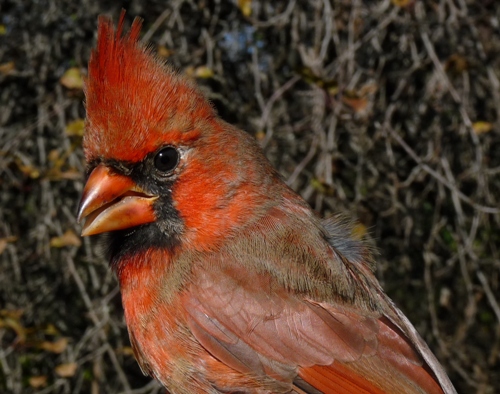 After being rather quiet for the past couple of months, Northern Cardinals were particularly active at MBO this week, perhaps reflecting the dispersal of this year’s young, such as the hatch-year male above (note the contrast in the wing between the new bright red primaries and the retained faded brown juvenile feathers to the right) (Photo by Marcel Gahbauer)
After being rather quiet for the past couple of months, Northern Cardinals were particularly active at MBO this week, perhaps reflecting the dispersal of this year’s young, such as the hatch-year male above (note the contrast in the wing between the new bright red primaries and the retained faded brown juvenile feathers to the right) (Photo by Marcel Gahbauer)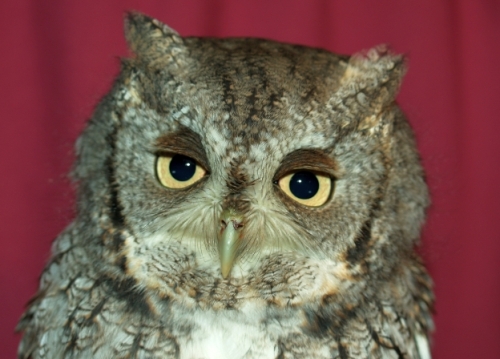 As the owl banding season nears a close, the nights are getting colder, but surprises like this make the effort rewarding. This Eastern Screech-Owl banded on Friday night was only the second in MBO’s history, although we have certainly heard them on a number of other occasions. (Photo by Simon Duval)
As the owl banding season nears a close, the nights are getting colder, but surprises like this make the effort rewarding. This Eastern Screech-Owl banded on Friday night was only the second in MBO’s history, although we have certainly heard them on a number of other occasions. (Photo by Simon Duval)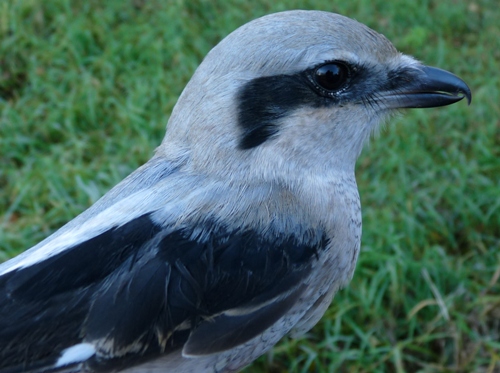 On Sunday we banded our second Northern Shrike in three days. Compared to the very brown individual at the end of
On Sunday we banded our second Northern Shrike in three days. Compared to the very brown individual at the end of 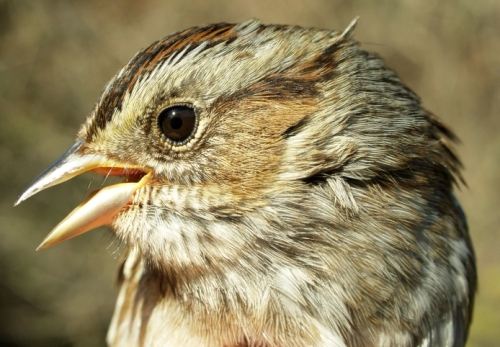 Swamp Sparrow isn’t usually a species we think of as a "winter bird" at MBO, and the fact we caught one this week probably just means it is a late-lingering fall migrant that happened to stay around a bit past the end of what we have officially defined as being the fall season. (Photo by Simon Duval)
Swamp Sparrow isn’t usually a species we think of as a "winter bird" at MBO, and the fact we caught one this week probably just means it is a late-lingering fall migrant that happened to stay around a bit past the end of what we have officially defined as being the fall season. (Photo by Simon Duval)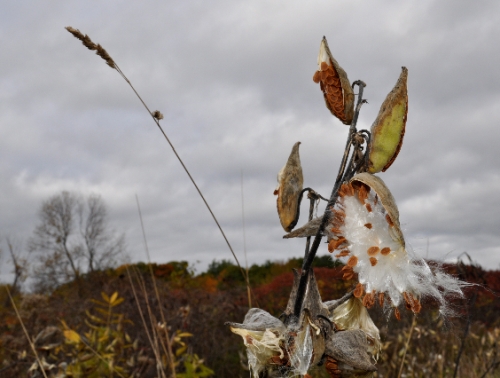 All around the site it looked and felt like late fall this week, with milkweed pods bursting against a largely brown background, and leaves tinged with frost accumulating on our boardwalks along the census trail. (Photos by Barbara Frei)
All around the site it looked and felt like late fall this week, with milkweed pods bursting against a largely brown background, and leaves tinged with frost accumulating on our boardwalks along the census trail. (Photos by Barbara Frei) 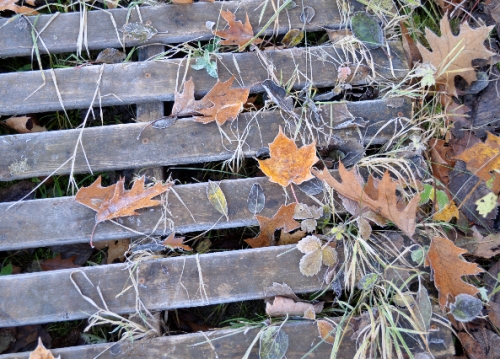
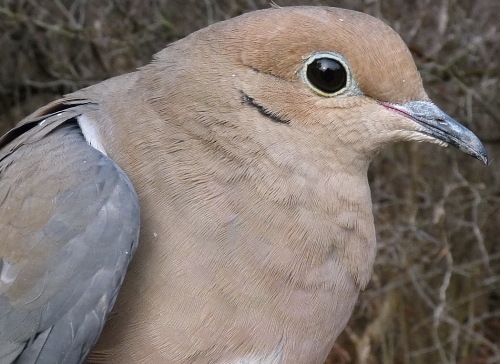 Although Mourning Doves are present at MBO throughout the year, we only ever catch them during winter. This individual was the first we banded in nearly three years, but several more followed later in the month. (Photo by Marcel Gahbauer)
Although Mourning Doves are present at MBO throughout the year, we only ever catch them during winter. This individual was the first we banded in nearly three years, but several more followed later in the month. (Photo by Marcel Gahbauer)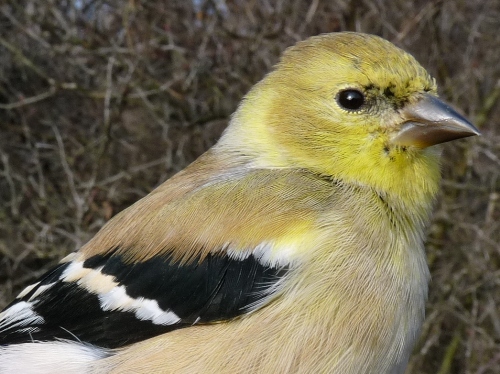 American Goldfinches were abundant this month, with all age and sex classes well represented. Some of the adult males were particularly colourful, including this one with a distinctly yellow head and even flecks of black on the forehead. (Photo by Marcel Gahbauer)
American Goldfinches were abundant this month, with all age and sex classes well represented. Some of the adult males were particularly colourful, including this one with a distinctly yellow head and even flecks of black on the forehead. (Photo by Marcel Gahbauer)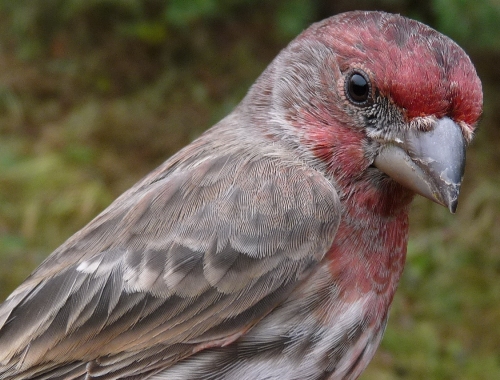 This month we banded House Finches for the first time in three years, and a good number of them at that. Among them were several very bright hatch-year males, including this one. Its age was given away by its wing (photo below), showing a distinct contrast between the primary and greater coverts, and also an eccentric moult limit among the primaries – the innermost four retained, contrasting with the darker and fresher outer primaries. (Photos by Marcel Gahbauer)
This month we banded House Finches for the first time in three years, and a good number of them at that. Among them were several very bright hatch-year males, including this one. Its age was given away by its wing (photo below), showing a distinct contrast between the primary and greater coverts, and also an eccentric moult limit among the primaries – the innermost four retained, contrasting with the darker and fresher outer primaries. (Photos by Marcel Gahbauer)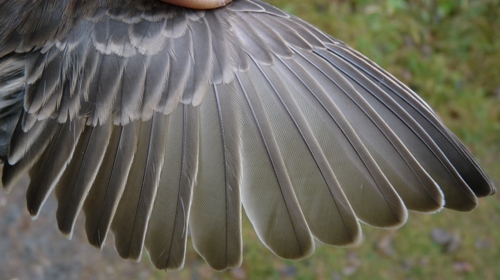
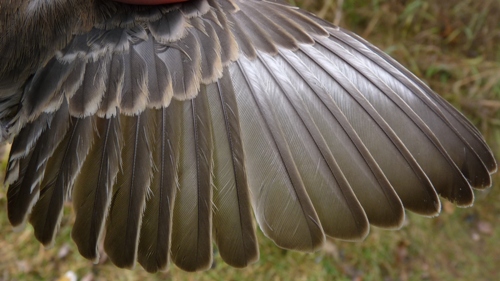 Another House Finch we caught in November showed this interesting white patch on both wings. (Photo by Marcel Gahbauer)
Another House Finch we caught in November showed this interesting white patch on both wings. (Photo by Marcel Gahbauer)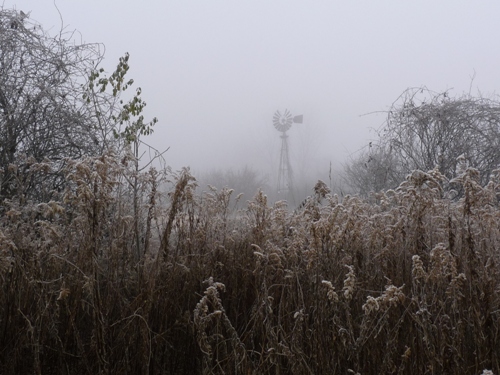 A beautiful frosty morning in late November, looking toward the old windmill from near the feeders. (Photos by Marcel Gahbauer)
A beautiful frosty morning in late November, looking toward the old windmill from near the feeders. (Photos by Marcel Gahbauer) 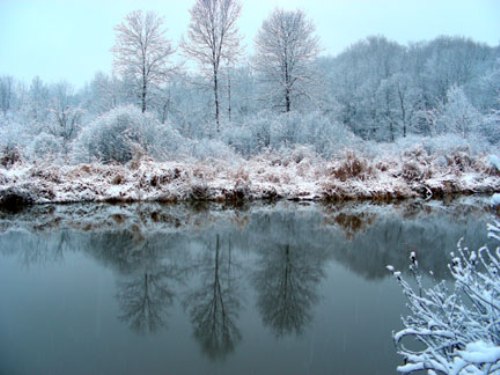 Snow began to fall right at the beginning of December, and has continued to accumulate on a number of occasions, transforming the landscape into truly wintry scenes like this. (Photo by Gay Gruner)
Snow began to fall right at the beginning of December, and has continued to accumulate on a number of occasions, transforming the landscape into truly wintry scenes like this. (Photo by Gay Gruner)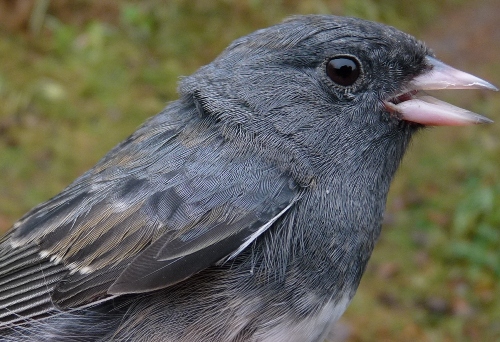 Juncos remained one of the most dominant species at MBO this month, which provided a nice opportunity to not only compare the appearance of different ages and sexes, but also the amount of variation within some classes. This hatch-year male (both above and below) was among those with the most minimal extent of preformative molt completed, with only the innermost greater coverts replaced, and the rest of the retained brown juvenile greater coverts easily visible even on the closed wing.. (Photos by Marcel Gahbauer)
Juncos remained one of the most dominant species at MBO this month, which provided a nice opportunity to not only compare the appearance of different ages and sexes, but also the amount of variation within some classes. This hatch-year male (both above and below) was among those with the most minimal extent of preformative molt completed, with only the innermost greater coverts replaced, and the rest of the retained brown juvenile greater coverts easily visible even on the closed wing.. (Photos by Marcel Gahbauer)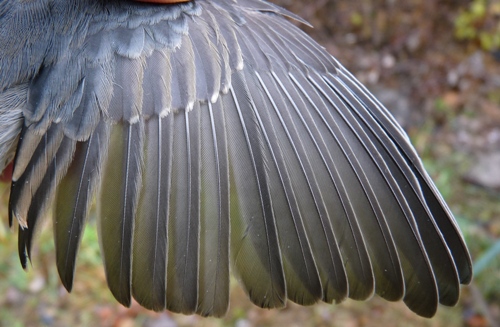
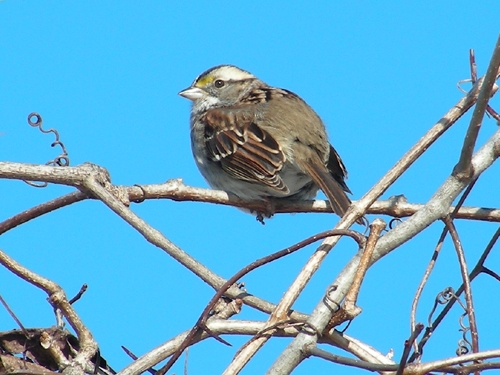 At least two White-throated Sparrows appear to be staying at MBO throughout the winter, including this one perched near the feeders. (Photo by Gay Gruner)
At least two White-throated Sparrows appear to be staying at MBO throughout the winter, including this one perched near the feeders. (Photo by Gay Gruner)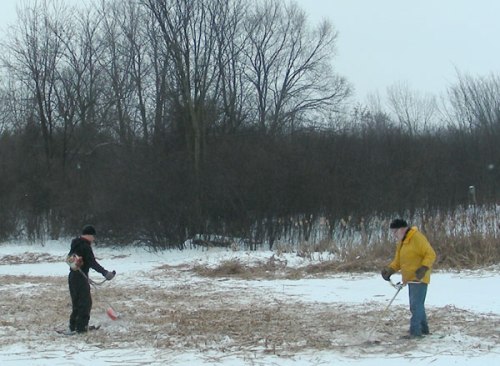 Above, Simon Duval and Malcolm Johnson wielding the heavy-duty cutters, and below, a team of others (Christine Burt, Barbara MacDuff, Kristen Keyes, Nikki Fleming) raking up the remains of the cattails. (Photos by Gay Gruner)
Above, Simon Duval and Malcolm Johnson wielding the heavy-duty cutters, and below, a team of others (Christine Burt, Barbara MacDuff, Kristen Keyes, Nikki Fleming) raking up the remains of the cattails. (Photos by Gay Gruner)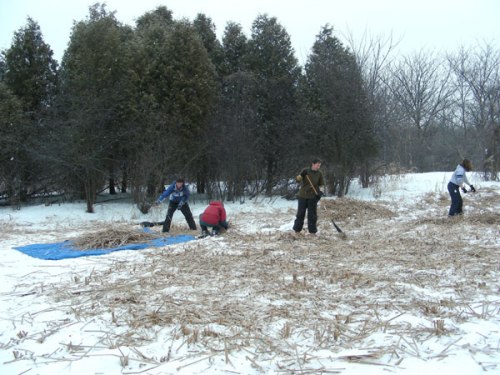 Below, the end result of a couple of days of hard work – Stoneycroft Pond actually looks like a pond again! We eagerly anticipate seeing it fill up in spring – both with water, and hopefully with birds that haven’t had enough open water the past couple of years, including the Pied-billed Grebes that formerly nested here. (Photo by Simon Duval)
Below, the end result of a couple of days of hard work – Stoneycroft Pond actually looks like a pond again! We eagerly anticipate seeing it fill up in spring – both with water, and hopefully with birds that haven’t had enough open water the past couple of years, including the Pied-billed Grebes that formerly nested here. (Photo by Simon Duval)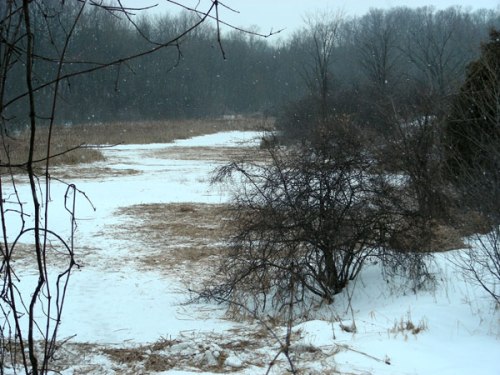
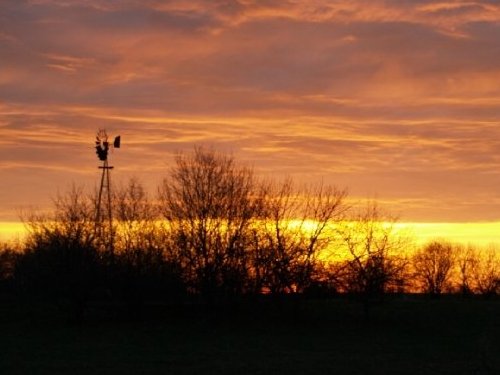 A last view of the venerable windmill at MBO, which lost its blades this month. (Photo by André Pelletier)
A last view of the venerable windmill at MBO, which lost its blades this month. (Photo by André Pelletier)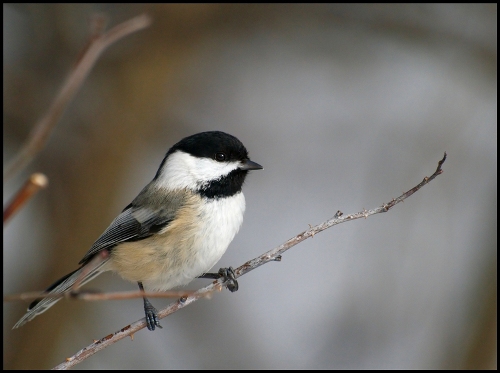 Black-capped Chickadee near the MBO feeders. (Photo by Simon Duval)
Black-capped Chickadee near the MBO feeders. (Photo by Simon Duval)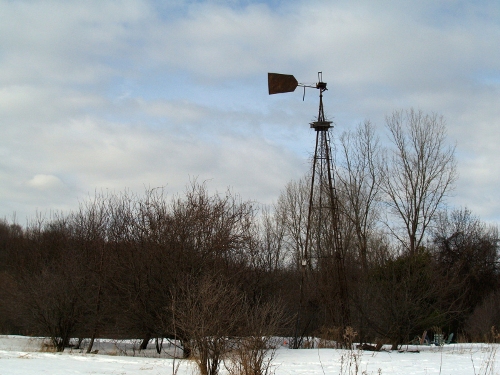 The newly naked "windmill stalk" above, and the blades on the ground below (Photos by Simon Duval)
The newly naked "windmill stalk" above, and the blades on the ground below (Photos by Simon Duval) Just days after the windmill blades came down, heavy winds littered MBO with broken branches, including plenty along the main access trail, below. (Photo by Gay Gruner)
Just days after the windmill blades came down, heavy winds littered MBO with broken branches, including plenty along the main access trail, below. (Photo by Gay Gruner)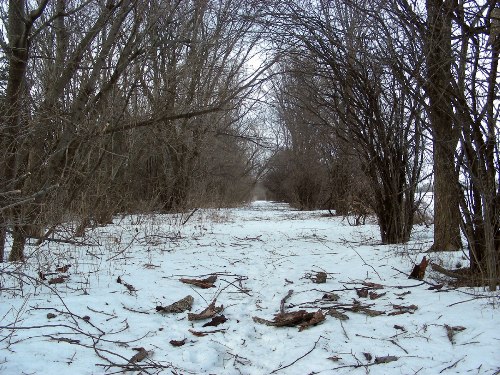
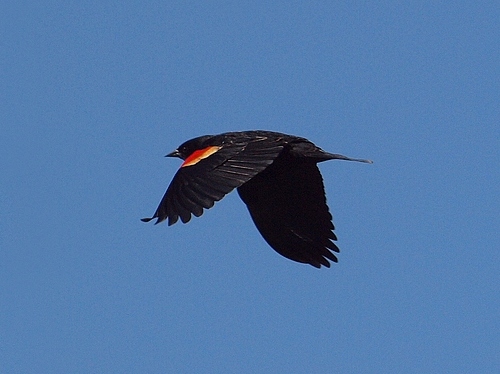 With the unusually early arrival of persistent warm spring weather, the Red-winged Blackbirds have been returning to MBO sooner than in other years. (Photo by Simon Duval)
With the unusually early arrival of persistent warm spring weather, the Red-winged Blackbirds have been returning to MBO sooner than in other years. (Photo by Simon Duval)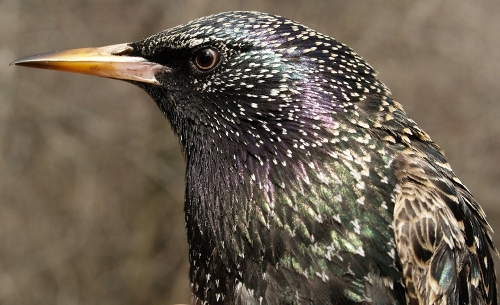 This European Starling is only the second banded at MBO during winter, the other one being caught three years ago. This individual was identified as female based on the pinkish (rather than bluish) lower mandible and yellowish iris. It was aged as a second-year bird based on the indistinct dark subterminal edging on the central rectrices, and a remaining trace of yellow on the tongue. (Photos by Simon Duval)
This European Starling is only the second banded at MBO during winter, the other one being caught three years ago. This individual was identified as female based on the pinkish (rather than bluish) lower mandible and yellowish iris. It was aged as a second-year bird based on the indistinct dark subterminal edging on the central rectrices, and a remaining trace of yellow on the tongue. (Photos by Simon Duval)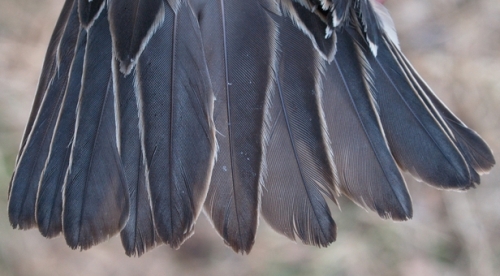
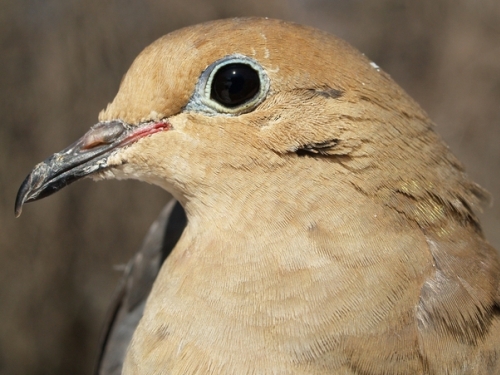 This female Mourning Dove banded on March 9 had an overgrown upper mandible. (Photo by Simon Duval)
This female Mourning Dove banded on March 9 had an overgrown upper mandible. (Photo by Simon Duval)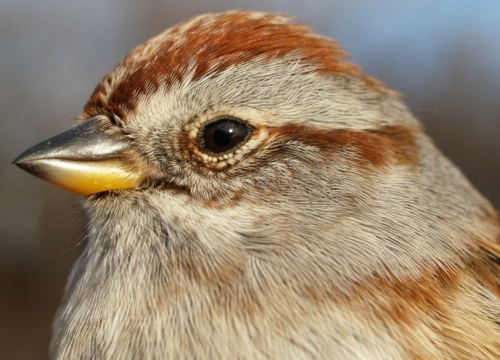 American Tree Sparrow was the species of the month in the nets, with nearly as many banded (23) this March as in all five previous winters combined (29). (Photo by Simon Duval)
American Tree Sparrow was the species of the month in the nets, with nearly as many banded (23) this March as in all five previous winters combined (29). (Photo by Simon Duval)